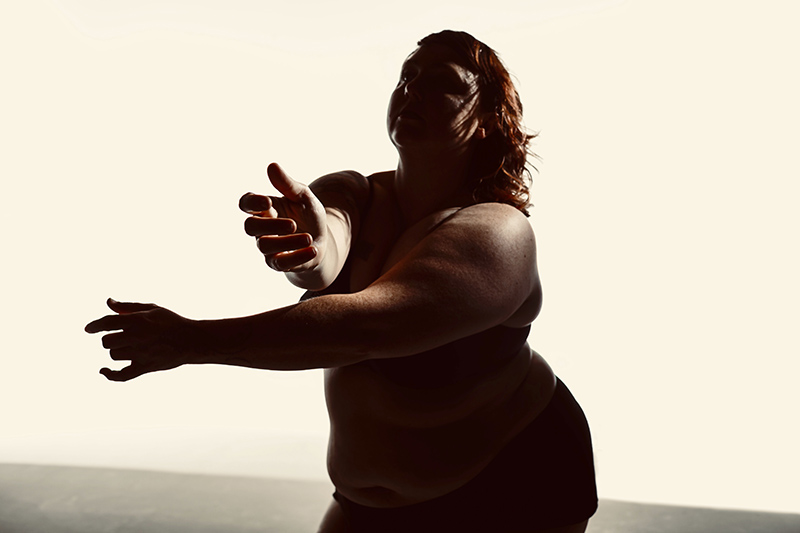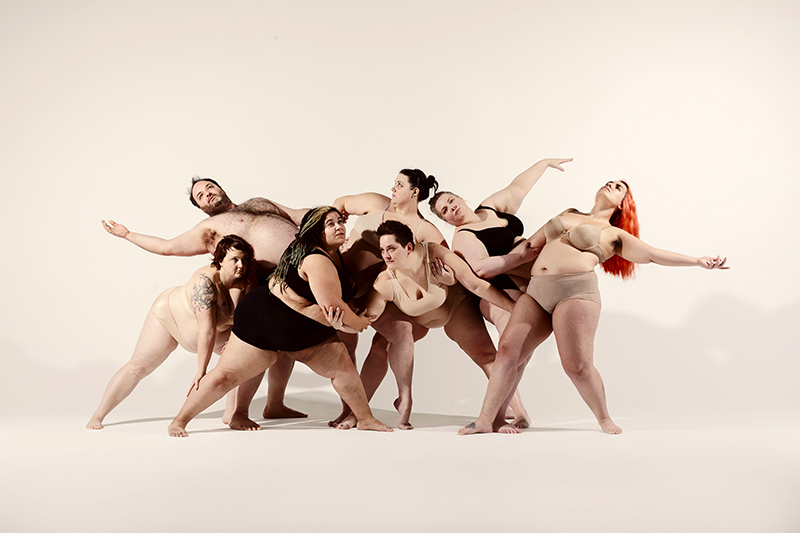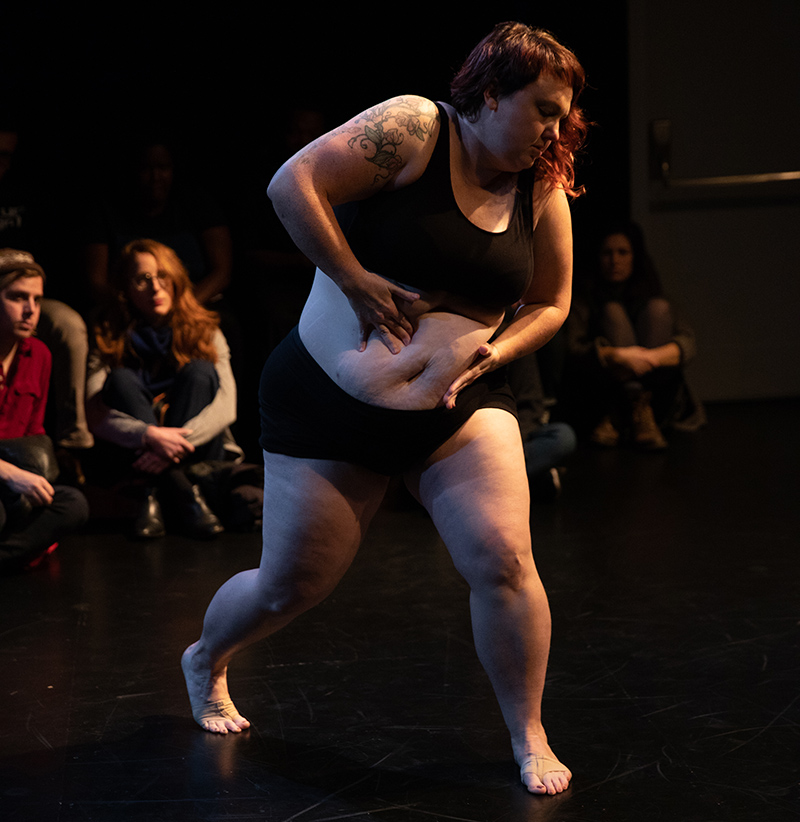Seeking Body Liberation, Not Body Positivity
An Interview with KT Kusmaul of Body Home Fat Dance
BY EMMALY WIEDERHOLT
KT Kusmaul is the founder and artistic director of Body Home Fat Dance, a company that creates performance and offers dance classes centering the fat community of Portland, OR. Here, KT shares how she started Body Home Fat Dance to build a space for fat dancers to feel safe and welcome, how she relishes exploring the unique traits of fat bodies in performance, and why she seeks body liberation, not body positivity.

Photo by Leah Nash
~~
Can you tell me about your dance history and what shaped who you are as an artist today?
I grew up taking dance classes. Even though I thought I was fat at the time, I wasn’t in a particularly large body, but I was large for a ballerina. That set the stage for understanding that I was never going to be good enough or have the right body. So when I was about 20, I quit dance. I’m 43 now, and things might be different these days, but in the 90s there weren’t opportunities for bigger dancers.
I didn’t dance for about 15 years. I filled that gap in my life with other things that were movement-based. In my mid-30s, I started taking dance classes again, and it was terrifying. I’m not just a little fat to be a dancer; I’m a lot fat to be a dancer. And I’m older. I was going into these classes and using all my energy just to be there and be okay with being there. People from dance backgrounds have a lot of learned shame around bodies and what’s acceptable. I never felt safe but I forged ahead even though it didn’t feel like a healing space.
I dabbled and tried a lot of different studios and techniques. I love modern dance, and I wanted to do choreography and structured warm-ups. I tried a bunch of studios around town, even adult beginner classes. I have since found belonging in butoh and experimental movement, but I couldn’t find that at the time, and I didn’t know where to look.
How did Body Home Fat Dance get started and how is it organized?
Body Home grew out of wanting something to exist. I didn’t feel qualified to rent a studio and teach dance, but out of desperation I needed to create a space. Full of imposter syndrome, I started teaching classes and showing up as who I am. And for a few years I had sold out classes and built a great community. Some of the participants had never danced before and wanted to be in community with other large bodies, while others were like me and there had been a rupture and they felt like they were no longer able to dance. That was how Body Home started. It was just a weekly community movement class.
I started Body Home within a year of finding dance again. I feel really lucky because the intersection of my identities was a real gift in this instance. I’m queer, fat, and non-binary, so I’ve always been in a community of DIY artists. What we want and need, we have to make for ourselves. I did a lot of drag and burlesque in my 20s and 30s. In those practices, you just share what you got and make something out of it. I think that’s why I felt able to start Body Home.
Currently there is not much happening with Body Home. At the beginning of the pandemic, I was teaching online classes, but I hated it. I didn’t feel fed or inspired like when we could gather face to face. It drove home how much the classes were about being in community. That didn’t translate for me online.
Is there a specific project or performance Body Home Fat Dance has presented that you want to share more about?
Out of meeting all these people at Body Home’s classes, I formed a small collective of 10 people or so. We started exploring movement in fat bodies. We got a residency at Performance Works NW. That was where the magic happened. We did a lot of exploring the problematic narrative of “we dance even though we’re fat.” That’s fine if that’s somebody else’s empowerment story, but I want to know what my body does specifically because I’m fat. How do I hold my flesh in my hands and move it and feel it ripple and jiggle? I wanted to explore that subversive side that fat people hide. You’re not supposed to see me jiggle or get out of breath. It’s embarrassing if you see me get up from the floor. Or there’s the feeling of not wanting somebody I’m partnering with to endure my weight. But what if we did that? Is there a safe way to do that? We came at it with curiosity. We explored our bodies in a way we hadn’t had permission to before.
It didn’t have to be beautiful. It didn’t have to be about loving our bodies, which is something that comes up a lot in the body positivity movement. Loving ourselves isn’t going to save us from systematic oppression. I don’t put much energy into loving my body, though that’s a nice result. For me, it’s about exploring the interesting, creative, emotive things my body can do specifically because I’m fat.
I can really only do that exploration when I’m with other fat-bodied people. I have this one dancer I worked with who has this big doughy belly. She can lay on her side and manipulate her belly by smushing it into the floor. I was jealous that she could do these cool things with her body. But when we go back into the world, her belly being larger than my own, she experiences more oppression than me with access to chairs and clothes as well as judgement from people around her. But in that creative space, I’m jealous of her belly.
Out of this research, I developed a piece called Weighted Bodies. It’s an iterative piece; there have been three versions so far. In its most recent iteration, it was a 20-minute piece that explored jiggling and undulations with a beautiful cast. Honestly, creating this piece made me think about sharing power in collaboration. I am the leader and my name gets stamped on things, but creating Weighted Bodies was a collaborative effort and as a result we had to process the concept of who gets credit.
We performed a short version of the piece in an early form at PDX Dance Collective Choreographers Showcase. Then I had the residency at Performance Works NW and that’s where we developed most of the piece and performed the next iteration. And then we created a third version that we performed at arts festivals in Seattle and Portland in 2019.

Photo by Leah Nash
The response was almost entirely positive. In Portland, a lot of fat community came to support it. They hadn’t seen themselves represented in art. People in the audience had amazing stories about seeing bodies like theirs and then going home and jiggling in front of the mirror. It spoke to people in a profound way. The arts community in general responded well because they had never seen fat dance like that before. I had only seen one production before that was similar and that was in Australia. The closest thing to negative comments we got were those patronizing remarks like, “You’re so brave.”
What are some ways people talk about fat dancers that carry problematic implications or assumptions?
You’re not supposed to be fat and be a dancer. You’re not supposed to even be an average build and be a dancer. You’re supposed to have a very specific body. You’re taught to be self-critical and compare yourself to bodies around you. The dance world is one of the most toxic body-loathing places I’ve ever been. Choreographers looking to cast dancers in their performances have that internalized. Arts programs have that internalized. Walking into a dance class is a terrifying experience. I felt this pressure to prove myself: I better be fucking good to show I belong there. But the truth was I hadn’t danced in 15 years.
I don’t want to be too critical of the social media body positivity movement because I wish there had been more representation and imagery of fat dancers when I was young. But it carries forward the narrative of “even though,” like, “I have extensions and can do turns even though I’m fat.” I’m glad for those dancers to get the attention they deserve, but I want to create space for people who don’t fit those narratives about what dance is.
There’s so much fat stigma that people deal with every moment of every day. A lot if it is external but a lot is internal because we have been constantly receiving messages that our bodies are gross or ill or incapable. As a result, fat people often become disembodied. They don’t feel like dance is an option. Creating dedicated fat spaces is important for people to see other people like them and feel like it’s possible to show up.
Are attitudes toward fat dancers getting better or worse from your perspective?
I’m no expert on what’s going on with younger dancers, but I get the impression that there is more opportunity and there are more conversations. People in their teens and 20s who want to pursue dance have more opportunities than I did 20 years ago. On the other hand, I live in a radical liberal bubble here in Portland that has large a fat liberation community, so it’s hard to know what’s going on in other places. I’ve personally felt a shift here in the Pacific Northwest with arts organizations that want to engage me. I don’t think that opportunity was there before.
What are some steps that professional and educational dance institutions can take to make their spaces more welcoming to fat dancers?
One of the biggest things would be having teachers who are in larger bodies. If I went to a studio and I knew they had teachers in larger bodies, even if it wasn’t the teacher of the class I was taking, that would feel more comfortable.
Another thing is if you’re putting on a production, make sure there is seating that accommodates larger bodies. Most theater seating is not comfortable for people over a certain size. Chairs with arms are especially risky, as well as chairs that are too close together. Sometimes theaters have chairs that are drilled into the ground. In the past, Body Home Fat Dance has rented chairs that have a higher weight capacity and created a well-spaced row in the front, which isn’t perfect, because then people can’t sit anywhere and might feel on display, but it’s what we’ve tried so far. I put a sign out that said, “These chairs are reserved for our friends in larger bodies.”
It would be great if studios had an ethical commitment among teachers to not use fat-phobic language. If we’re doing sit-ups, for example, why do we have to talk about “flattening the belly” or “fat blasting,” as if the only goal of exercise is to lose weight? Studios could even make dedicated classes for larger bodies. There are some yoga studios that have “yoga for bigger bodies,” which can be an entry point. And if you’re going to sell t-shirts, make sizes available beyond an XL.
What terminology are you comfortable with?
“Body positivity” or “fat positive” are really popular terms right now, but it’s not the language I choose to use. I don’t want to feel positive; I want to be liberated. If society doesn’t stop making my life hard, that doesn’t solve the problem, even if I like myself better. I like “fat liberation,” “body liberation,” or “body sovereignty.” I’m not scared of the word “fat,” and I use it freely to talk about my work, but I interchange it with “people in bigger bodies.” It’s a bit more neutral. There’s debate about who gets to say the word “fat” and whether non-fat people should say the word “fat.” For me, if I’m having a conversation with someone who has a shared analysis, then I’m okay with the word “fat,” but if it’s someone saying, “I made a cake but I couldn’t possibly eat it because I don’t want to get fat,” then that is not okay. I think the safer term is “people in larger bodies.”
Do you have an upcoming project or focus you’d like to share more about?
I’m getting ready to make another big pivot personally and professionally. My day job is a nurse, and I am in grad school to become a psychiatric nurse practitioner. I’m hoping to find a way to bridge all the therapeutic and creative movement work I’ve been exploring through Body Home Fat Dance with my newfound knowledge about our nervous systems and mental health. I’m hoping to do that as a psychiatric nurse practitioner with a private practice while continuing to offer my dance classes that are meant to be just fun. I want to empower people to explore their nervous systems and explore how movement can re-embody them. People in fat bodies often get messages that being in their bodies isn’t safe. I want to help them meet their body again.

Photo by Naomi Ishisaka
~~
To learn more, visit www.bodyhomefatdance.com.
